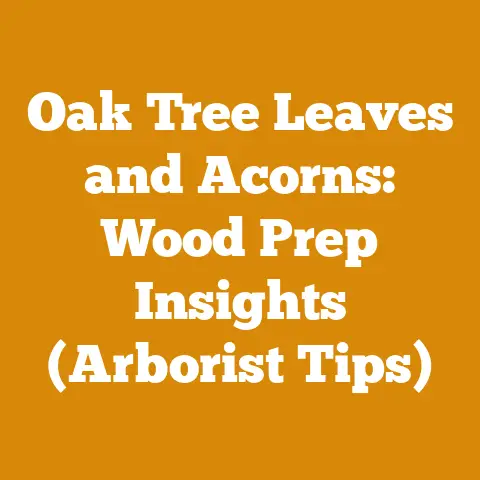How to Identify Wood Types (Expert Tips for Chainsaw Pros)
How to Identify Wood Types (Expert Tips for Chainsaw Pros)
Introduction: The Art and Science of Wood ID
In the world of wood processing, logging, and firewood preparation, identifying wood types isn’t just a neat trick; it’s a fundamental skill that directly impacts efficiency, safety, and, most importantly, your bottom line. We are living in an era of innovation where we have tools and techniques at our disposal that our predecessors could only dream of. From advanced moisture meters to online wood databases, the modern woodworker has access to a wealth of information. But at its core, wood identification remains a blend of scientific understanding and practical experience.
I’ve spent years felling trees, milling lumber, and splitting firewood, and I can tell you firsthand that knowing your oak from your ash, your maple from your birch, can save you time, money, and a whole lot of frustration. This article dives deep into the world of wood identification, offering expert tips and practical insights that will benefit both seasoned chainsaw pros and enthusiastic beginners.
Why Wood Identification Matters: More Than Just Knowing Names
Before we get into the nitty-gritty of identifying specific wood types, let’s understand why it’s so crucial.
- Optimizing Chainsaw Performance: Different wood types have varying densities and grain structures. Knowing what you’re cutting allows you to choose the right chain, bar oil, and cutting technique, minimizing wear and tear on your chainsaw.
- Predicting Splitting Behavior: Some woods, like elm, are notoriously difficult to split, while others, like ash, practically fall apart. Identifying the wood beforehand lets you adjust your splitting strategy and avoid unnecessary back strain.
- Understanding Drying Times: Wood species vary significantly in how quickly they dry and how prone they are to checking and warping. Proper identification allows you to manage the drying process effectively, reducing waste and ensuring high-quality firewood or lumber.
- Predicting Burning Qualities: For firewood, knowing the wood type is critical for understanding its BTU (British Thermal Unit) output, burn time, and smoke production. This knowledge allows you to provide customers with the best possible product and avoid selling underperforming wood.
- Cost Estimation and Budgeting: The price of wood varies greatly depending on the species. Knowing the value of the wood you’re working with is essential for accurate cost estimation and maximizing your profit margins.
The Tools of the Trade: Essential Equipment for Wood Identification
While experience is invaluable, having the right tools can significantly improve your accuracy and efficiency. Here are some of the key tools I recommend:
- Hand Lens (Magnifying Glass): A 10x or 20x hand lens is essential for examining the fine details of wood grain and cellular structure. Look for one with a built-in light for better visibility.
- Sharp Knife or Razor Blade: A sharp blade is needed to make clean cuts across the wood grain for closer examination.
- Moisture Meter: A moisture meter is crucial for determining the moisture content of wood, which can affect its color, weight, and splitting behavior.
- Wood Identification Key or Guide: There are numerous wood identification keys and guides available, both in print and online. These guides provide detailed descriptions and images of various wood species.
- Reference Samples: Collecting a set of reference samples of known wood types is an excellent way to build your identification skills. Label each sample clearly and store them in a dry place.
- Smartphone with Camera: A smartphone camera can be used to take close-up photos of wood samples for later comparison and analysis.
- Wood Database Apps: Several smartphone apps are available that provide detailed information about different wood species, including images, characteristics, and uses.
Key Characteristics to Observe: The Detective Work of Wood Identification
Identifying wood is like detective work. You need to gather clues and analyze the evidence to arrive at the correct conclusion. Here are some of the key characteristics to observe:
1. Color and Grain Pattern
- Color: Wood color can vary widely, from the creamy white of aspen to the dark brown of walnut. However, color can be affected by factors such as age, exposure to sunlight, and staining, so it’s not always a reliable indicator.
- Grain Pattern: The grain pattern is determined by the arrangement of the wood cells and growth rings. Look for features such as straight grain, wavy grain, interlocked grain, and burl patterns.
2. Hardness and Density
- Hardness: Hardness refers to the wood’s resistance to indentation and scratching. You can test hardness by trying to scratch the wood with your fingernail or a sharp object. Hardwoods are generally denser and more difficult to scratch than softwoods.
- Density: Density is the mass per unit volume of the wood. You can estimate density by lifting the wood and comparing its weight to other samples. Denser woods are generally stronger and more durable.
3. Ring Porosity
Ring porosity refers to the size and arrangement of the pores (vessels) in the wood. There are three main types of ring porosity:
- Ring-Porous: The pores are large and distinct, forming a prominent ring at the beginning of each growth ring (e.g., oak, ash).
- Diffuse-Porous: The pores are small and evenly distributed throughout the growth ring (e.g., maple, birch).
- Non-Porous: There are no visible pores (e.g., conifers like pine, fir).
4. Odor
Some wood species have a distinctive odor that can aid in identification. For example, cedar has a characteristic aromatic scent, while black cherry has a faint almond-like odor.
5. End Grain Features
The end grain of wood reveals the arrangement of the growth rings, pores, and other cellular structures. Examining the end grain with a hand lens can provide valuable clues for identification.
6. Weight
While subjective, experienced woodworkers can often distinguish between wood types based on relative weight. Density plays a huge role.
7. Bark Characteristics
While this is most useful when the tree is standing, bark can provide clues. Consider the texture, color, and pattern of the bark.
Identifying Common Wood Types: A Practical Guide
Now, let’s put these techniques into practice by examining some common wood types:
Hardwoods
- Oak (Quercus spp.): Oak is a strong, durable hardwood with a distinctive ring-porous grain pattern. There are two main types of oak: red oak and white oak. Red oak has open pores and is more absorbent, while white oak has closed pores and is more resistant to decay. Oak is widely used for furniture, flooring, and construction. The price of oak can vary widely depending on the region and the grade, but I’ve seen it range from \$3 to \$8 per board foot.
- Maple (Acer spp.): Maple is a hard, dense hardwood with a fine, diffuse-porous grain pattern. There are two main types of maple: hard maple (sugar maple) and soft maple (red maple). Hard maple is stronger and more durable than soft maple. Maple is commonly used for furniture, flooring, and musical instruments. Expect to pay between \$4 and \$9 per board foot for maple.
- Ash (Fraxinus spp.): Ash is a strong, flexible hardwood with a prominent ring-porous grain pattern. It is known for its excellent splitting properties and is often used for tool handles, baseball bats, and firewood. Ash prices typically fall in the \$3 to \$7 per board foot range.
- Birch (Betula spp.): Birch is a relatively soft hardwood with a fine, diffuse-porous grain pattern. It is light in color and easy to work with. Birch is commonly used for plywood, veneer, and furniture. Birch is often a more affordable option, ranging from \$2 to \$6 per board foot.
- Cherry (Prunus serotina): Cherry is a moderately hard hardwood with a distinctive reddish-brown color and a fine, diffuse-porous grain pattern. It is prized for its beautiful appearance and is often used for furniture, cabinetry, and decorative items. Cherry prices can be higher, often between \$6 and \$12 per board foot.
- Walnut (Juglans nigra): Walnut is a strong, durable hardwood with a rich, dark brown color and a distinctive grain pattern. It is highly valued for its beauty and is often used for furniture, gun stocks, and decorative items. Walnut is one of the more expensive hardwoods, often exceeding \$10 per board foot, and sometimes reaching \$20 or more for high-quality pieces.
Softwoods
- Pine (Pinus spp.): Pine is a softwood with a light color and a straight grain pattern. It is relatively soft and easy to work with. Pine is widely used for construction, furniture, and paper production. Pine is generally an affordable option, with prices often under \$3 per board foot.
- Fir (Abies spp.): Fir is a softwood with a light color and a straight grain pattern. It is stronger and more durable than pine. Fir is commonly used for construction, framing, and plywood. Fir prices are similar to pine, often under \$4 per board foot.
- Cedar (Thuja spp.): Cedar is a softwood with a distinctive aromatic scent and a reddish-brown color. It is naturally resistant to decay and insects. Cedar is commonly used for siding, shingles, and outdoor furniture. Cedar can be more expensive than pine or fir, ranging from \$4 to \$8 per board foot depending on the species and grade.
- Spruce (Picea spp.): Spruce is a softwood with a light color and a straight grain pattern. It is strong and lightweight. Spruce is commonly used for construction, musical instruments, and paper production. Spruce prices are comparable to pine and fir.
Cost Considerations: Factoring in Wood Type When Budgeting
The type of wood you choose will significantly impact your project costs. Here’s how to factor in wood type when budgeting:
- Timber Purchase or Harvesting Costs: Hardwoods are generally more expensive than softwoods due to their slower growth rates and higher demand. Exotic hardwoods can be significantly more expensive due to their rarity and transportation costs. If you’re harvesting your own wood, consider the time and effort required to fell, buck, and transport different species.
- Tool Maintenance: Harder woods will dull your chainsaw blades and other tools more quickly, increasing maintenance costs.
- Drying Costs: Some wood species require longer drying times and are more prone to checking and warping, increasing the risk of waste and the need for specialized drying equipment.
- Labor Wages: If you’re hiring labor, the difficulty of working with certain wood types can affect labor costs. For example, splitting elm can take significantly longer than splitting ash, increasing labor time and expense.
Data-Backed Insights:
- According to the USDA Forest Service, the average stumpage price (the price paid for standing timber) for hardwood sawtimber in the United States in 2023 was \$215 per thousand board feet, while the average stumpage price for softwood sawtimber was \$110 per thousand board feet. This illustrates the general price difference between hardwoods and softwoods at the source.
- A study by the University of Minnesota Extension found that the average cost of producing a cord of firewood from hardwood was \$150-\$250, while the average cost of producing a cord of firewood from softwood was \$100-\$200. The increased cost for hardwood is due to the higher cost of the wood itself and the increased labor required to split and handle it.
Cost Optimization Tips: Getting the Most Bang for Your Buck
Here are some practical tips for optimizing your costs when working with wood:
- Choose Locally Sourced Wood: Sourcing wood locally can significantly reduce transportation costs and support local economies.
- Consider Alternative Wood Types: If you’re working on a project where the wood type is not critical, consider using a more affordable alternative.
- Negotiate Prices: Don’t be afraid to negotiate prices with your lumber supplier, especially if you’re buying in bulk.
- Utilize Waste Wood: Find creative ways to utilize waste wood from other projects, such as making small crafts or using it for firewood.
- Properly Maintain Your Tools: Keeping your chainsaw blades sharp and your other tools in good working order will reduce wear and tear and improve efficiency.
- Dry Wood Properly: Proper drying techniques will minimize waste and ensure high-quality lumber or firewood.
- Consider renting specialized tools: For example, renting a wood splitter for a large firewood project can be more cost-effective than purchasing one. Rental fees typically range from \$50 to \$150 per day, depending on the size and type of splitter.
Case Study: Budgeting a Firewood Project
Let’s look at a case study to illustrate how wood type affects budgeting for a firewood project.
Scenario: You’re planning to produce 10 cords of firewood for sale.
Option 1: Using Ash
- Cost of Ash Timber: \$50 per cord (standing timber) x 10 cords = \$500
- Labor Costs (felling, bucking, splitting, stacking): \$100 per cord x 10 cords = \$1000
- Chainsaw Maintenance (fuel, oil, chain sharpening): \$20 per cord x 10 cords = \$200
- Transportation Costs: \$50
- Total Cost: \$1750
Option 2: Using Elm
- Cost of Elm Timber: \$30 per cord (standing timber) x 10 cords = \$300
- Labor Costs (felling, bucking, splitting, stacking): \$150 per cord x 10 cords = \$1500 (due to difficulty splitting)
- Chainsaw Maintenance (fuel, oil, chain sharpening): \$30 per cord x 10 cords = \$300 (due to increased wear)
- Transportation Costs: \$50
- Total Cost: \$2150
As you can see, even though elm timber is cheaper, the increased labor and maintenance costs associated with splitting it make it a less cost-effective option.
Calculations and Formulas: Estimating Wood Volume and Drying Time
Here are some useful calculations and formulas for wood processing:
- Estimating Log Volume (Doyle Log Scale): (Diameter in inches – 4)^2 * Length in feet / 16. This formula provides an estimate of the board feet of lumber that can be sawn from a log.
- Estimating Cord Volume: A standard cord of wood is 4 feet high, 4 feet wide, and 8 feet long, for a total volume of 128 cubic feet. However, the actual amount of solid wood in a cord varies depending on the size and shape of the pieces.
- Estimating Drying Time: Drying time depends on factors such as wood species, thickness, initial moisture content, and drying conditions. As a general rule, hardwoods take longer to dry than softwoods. You can use a moisture meter to track the drying process and determine when the wood is ready for use.
Challenges Faced by Small-Scale Loggers and Firewood Suppliers
Small-scale loggers and firewood suppliers face numerous challenges, including:
- Fluctuating Timber Prices: Timber prices can fluctuate significantly depending on market conditions and demand.
- Competition from Larger Operations: Larger logging and firewood operations often have economies of scale that allow them to undercut smaller businesses.
- Regulations and Permits: Logging and firewood operations are subject to various regulations and permit requirements, which can be costly and time-consuming to comply with.
- Weather Conditions: Weather conditions can significantly impact logging and firewood production, making it difficult to maintain a consistent supply.
- Finding Reliable Labor: Finding and retaining reliable labor can be a challenge, especially in rural areas.
The Language of Wood: Useful Idioms and Expressions
Here are some common idioms and expressions related to wood that you might encounter:
- “Knock on wood”: A superstitious expression used to ward off bad luck.
- “Out of the woods”: Meaning out of danger or difficulty.
- “Barking up the wrong tree”: Meaning pursuing the wrong course of action.
- “Don’t take any wooden nickels”: A warning not to be fooled or deceived.
- “As sound as a dollar”: Meaning in good condition or health (originally “sound as a wooden tree-nail”).
Actionable Takeaways and Next Steps
By now, you should have a solid understanding of how to identify wood types and how wood type affects your costs. Here are some actionable takeaways and next steps:
- Practice Your Identification Skills: Collect wood samples and practice identifying them using the techniques described in this article.
- Research Local Wood Prices: Contact local lumber suppliers and firewood dealers to get an idea of current prices in your area.
- Create a Detailed Budget: Before starting any wood processing or firewood project, create a detailed budget that includes all relevant costs, including wood type, labor, tools, and transportation.
- Continuously Improve Your Skills: Attend workshops, read books, and network with other woodworkers to continuously improve your skills and knowledge.
Conclusion: Embracing the Expertise
Identifying wood types is a valuable skill that can save you time, money, and frustration. By combining scientific knowledge with practical experience, you can become a true chainsaw pro and master of the wood processing world. Remember, the journey of a thousand miles begins with a single step – so get out there, start identifying wood, and embrace the expertise!






